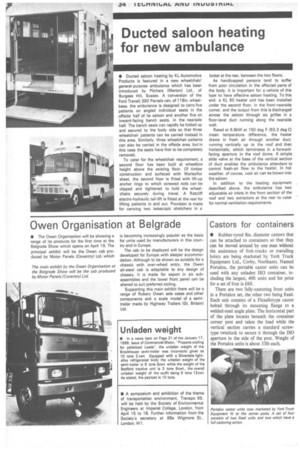Ducted saloon heating for new ambulance
Page 36

If you've noticed an error in this article please click here to report it so we can fix it.
• Ducted saloon heating by KL Automotive Products is featured in a new wheelchair/ general-purpose ambulance which has been introduced by Pilchers (Merton) Ltd., of Burgess Hill, Sussex. A conversion of the Ford Transit 390 Parcels van, of 118in. wheelbase, the ambulance is designed to carry five patients on angled individual seats in the offside half of its saloon and another five on inward-facing bench seats, in the nearside half. The bench seats can rapidly be folded up and secured to the body side so that three wheelchair patients can be carried instead in this area. Similarly, three wheelchair patients can also be carried in the offside area, but in this case the seats have first to be completely removed.
To cater for the wheelchair requirement, a second floor has been built at wheelbox height above the existing floor. Of timber construction and surfaced with Marleyffor sheet, the second floor is fitted with lift-up anchor rings to which screwed rods can be clipped and tightened to hold the wheelchairs securely during travel. A Ratcliff electro-hydraulic tail-lift is fitted at the rear for lifting patients in and out. Provision is made for carrying two telescopic stretchers in a locker at the rear, between the two floors.
As handicapped persons tend to suffer from poor circulation in the affected parts of the body, it is important for a vehicle of this type to have effective saloon heating. To this end, a KL 90 heater unit has been installed under the second floor, in the front nearside corner, and the output from this is discharged across the saloon through six grilles in a floor-level duct running along the nearside wall.
Rated at 6.8kW at 150 deg F (83.3 deg C) mean temperature difference, the heater draws in fresh air through another duct running vertically up to the roof and then horizontally, which terminates in a forwardfacing aperture in the roof dome. A simple slide valve at the base of the vertical section of duct enables the ambulance attendant to control fresh-air flow to the heater. In hot weather, of course, cool air can be blown into the saloon.
In addition to the heating equipment described above, the ambulance has two adjustable air inlets in the front section of the roof and two extractors at the rear to cater for normal ventilation requirements.




































































































